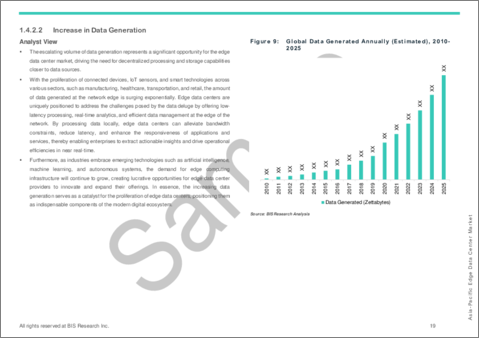|
|
市場調査レポート
商品コード
1553408
アジア太平洋のエッジデータセンター市場:製品・用途・地域別の分析・予測 (2023-2033年)Asia-Pacific Edge Data Center Market: Focus on Product, Application, and Country - Analysis and Forecast, 2023-2033 |
||||||
カスタマイズ可能
|
|||||||
| アジア太平洋のエッジデータセンター市場:製品・用途・地域別の分析・予測 (2023-2033年) |
|
出版日: 2024年09月12日
発行: BIS Research
ページ情報: 英文 54 Pages
納期: 1~5営業日
|
- 全表示
- 概要
- 図表
- 目次
アジア太平洋のエッジデータセンターの市場規模は、2023年の53億6,000万米ドルから、予測期間中は19.40のCAGRで推移し、2033年には315億7,000万米ドルの規模に成長すると予測されています。
同地域のエッジデータセンター市場の拡大を後押ししている主な要因の1つは、エッジコンピューティングに対する需要の高まりです。エッジコンピューティングは、よりソースに近いところでデータを処理することで、集中型データウェアハウスへの依存を軽減します。特にモバイルコンピューティング、スマートシティ、IoTデバイスのような用途では、データ処理における迅速な処理と低遅延のニーズがこの成長を後押ししています。同地域がデジタルインフラの改善に注力し、リアルタイムのデータ処理に対する需要の高まりを満たす中で、エッジコンピューティングへの動向はより顕著になってきています。
| 主要市場統計 | |
|---|---|
| 予測期間 | 2023-2033年 |
| 2023年評価 | 53億6,000万米ドル |
| 2033年予測 | 315億7,000万米ドル |
| CAGR | 19.4% |
アジア太平洋地域の急速なデジタルトランスフォーメーションと低遅延コンピューティングソリューションに対する需要の高まりが、同地域のエッジデータセンター市場の堅調な成長を後押ししています。エッジデータセンターは、モバイルアプリケーション、スマートシティ、IoTなどの新興技術をサポートするために必要とされています。エッジデータセンターは、よりソースに近い場所でデータを処理します。このローカライズされた方法により、データ処理速度が向上し、待ち時間が短縮され、ネットワーク全体のパフォーマンスが向上します。
アジア太平洋地域におけるデータトラフィックの増加とリアルタイムデータアナリティクスへの需要も同地域のエッジデータセンターの拡大を促進しています。企業や消費者のデータ集約型用途への依存度が高まるにつれ、より高速なレスポンスタイムと効率性を備えたエッジコンピューティングソリューションへのニーズが高まっています。
政府の取り組みやデジタルインフラへの投資により、都市部と農村部の両方でエッジデータセンターの設置が促進され、市場は拡大しています。技術開発の結果、より効率的でスケーラブルなエッジソリューションが開発されており、これにはデータセンターアーキテクチャの改善や省エネルギー化も含まれます。同地域が技術革新における主導的地位を維持する限り、エッジデータセンター市場は大きく成長し、同地域のステークホルダーに大きな事業機会をもたらすと期待されています。
市場セグメンテーション:
セグメンテーション1:エンドユーザー産業別
- IT・電気通信
- 銀行・金融サービス・保険(BFSI)
- 政府・公共部門
- ヘルスケア
- 製造
- 自動車
- 小売
- その他
セグメンテーション2:データセンタータイプ別
- オンプレミスエッジ
- ネットワークエッジ
- リージョナルエッジ
セグメンテーション3:地域別
- 中国、日本、オーストラリア、その他
当レポートでは、アジア太平洋のエッジデータセンターの市場を調査し、業界の動向、技術・特許の動向、市場成長促進要因・抑制要因、市場規模の推移・予測、各種区分・主要国別の詳細分析、競合情勢、主要企業のプロファイルなどをまとめています。
目次
エグゼクティブサマリー
第1章 市場
- 動向:現在および将来の影響評価
- エッジデータセンター市場を形成する動向
- 5Gネットワークの展開
- IoTデバイスの普及
- SDN技術の採用
- サプライチェーンの概要
- バリューチェーン分析
- マーケットマップ
- R&Dレビュー
- 特許出願動向(国・企業別)
- 市場力学の概要
- 市場促進要因
- 市場抑制要因
- 市場機会
第2章 地域
- 地域別概要
- アジア太平洋
- 主要参入企業
- 地域概要
- 市場成長推進因子
- 市場課題
- 用途
- 製品
- 中国
- 用途
- 製品
- 日本
- 用途
- 製品
- オーストラリア
- 用途
- 製品
- その他
- 用途
- 製品
第3章 市場:競合ベンチマーキングと企業プロファイル
- 競合情勢
- 企業プロファイル
- 最先端データセンター
第4章 調査手法
List of Figures
- Figure 1: Edge Data Center Market (by Region), $Million, 2022, 2026, and 2033
- Figure 2: Asia-Pacific Edge Data Center Market (by End-Use Industry), $Million, 2022, 2026, and 2033
- Figure 3: Asia-Pacific Edge Data Center Market (by Type), $Million, 2022, 2026, and 2033
- Figure 4: Global Population Coverage by Technology, 2023 and 2029
- Figure 5: Supply Chain Analysis for Edge Data Center Market
- Figure 6: Patent Filed (by Country), January 2020-December 2023
- Figure 7: Patent Filed (by Company), January 2020-December 2023
- Figure 8: Impact Analysis of Edge Data Center Market Navigating Factors, 2023-2033
- Figure 9: AI Publications (% of Total) by Sector and Geographic Area, 2021
- Figure 10: Global Data Generated Annually (Estimated), 2010-2025
- Figure 11: Share of Strategic Initiatives, 2023
- Figure 12: Data Triangulation
- Figure 13: Top-Down and Bottom-Up Approach
- Figure 14: Assumptions and Limitations
List of Tables
- Table 1: Market Snapshot
- Table 2: Edge Data Center Market, Opportunities across Regions
- Table 3: Edge Data Center Market (by Region), $Million, 2022-2033
- Table 4: Asia-Pacific Edge Data Center Market (by End-Use Industry), $Million, 2022-2033
- Table 5: Asia-Pacific Edge Data Center Market (by Type), $Million, 2022-2033
- Table 6: China Edge Data Center Market (by End-Use Industry), $Million, 2022-2033
- Table 7: China Edge Data Center Market (by Type), $Million, 2022-2033
- Table 8: Japan Edge Data Center Market (by End-Use Industry), $Million, 2022-2033
- Table 9: Japan Edge Data Center Market (by Type), $Million, 2022-2033
- Table 10: Australia Edge Data Center Market (by End-Use Industry), $Million, 2022-2033
- Table 11: Australia Edge Data Center Market (by Type), $Million, 2022-2033
- Table 12: Rest-of-Asia-Pacific Edge Data Center Market (by End-Use Industry), $Million, 2022-2033
- Table 13: Rest-of-Asia-Pacific Edge Data Center Market (by Type), $Million, 2022-2033
- Table 14: Market Share, 2022
Introduction to Asia-Pacific Edge Data Center Market
The Asia-Pacific edge data center market, valued at $5.36 billion in 2023, is expected to reach $31.57 billion by 2033, exhibiting a robust CAGR of 19.40% during the forecast period 2023-2033. One of the main factors propelling the edge data center market's expansion in APAC is the rising demand for edge computing. Edge computing lessens dependency on centralized data warehouses by processing data closer to the source, which is anticipated to result in a rapid deployment of edge data centers. The need for quicker processing and lower latency in data handling is what is driving this growth, especially for applications like mobile computing, smart cities, and Internet of Things (IoT) devices. With APAC concentrating on improving digital infrastructure and satisfying the increasing demand for real-time data processing, the trend towards edge computing is becoming more noticeable.
Market Introduction
| KEY MARKET STATISTICS | |
|---|---|
| Forecast Period | 2023 - 2033 |
| 2023 Evaluation | $5.36 Billion |
| 2033 Forecast | $31.57 Billion |
| CAGR | 19.4% |
The rapid digital transformation of the region and the rising demand for low-latency computing solutions are driving the robust growth of the APAC edge data center market. Edge data centers are becoming necessary to support emerging technologies like mobile applications, smart cities, and the Internet of Things (IoT). These centers process data closer to the source. This localized method boosts data processing speed, lowers latency, and enhances network performance overall.
The growing data traffic in the region and the demand for real-time data analytics are driving the expansion of edge data centers in Asia-Pacific. The need for edge computing solutions with faster response times and more efficiency is growing as businesses and consumers depend more and more on data-intensive applications.
The market is expanding as a result of government initiatives and investments in digital infrastructure, which facilitate the installation of edge data centers in both urban and rural areas. More efficient and scalable edge solutions are being developed as a result of technological developments, which also include improvements in data center architecture and energy conservation. The edge data center market is expected to grow significantly, providing substantial opportunities for stakeholders in the region, as long as APAC maintains its leadership position in technological innovation.
Market Segmentation:
Segmentation 1: by End-Use Industry
- IT and Telecom
- Banking, Financial Services, and Insurance (BFSI)
- Government and Public Sector
- Healthcare
- Manufacturing
- Automotive
- Retail
- Others
Segmentation 2: by Data Center Type
- On-Premise Edge
- Network Edge
- Regional Edge
Segmentation 3: by Region
- Asia-Pacific - China, Japan, Australia, and Rest-of-Asia-Pacific
How can this report add value to an organization?
Product/Innovation Strategy: The product segment helps the reader understand the different application and product segments of edge data centers and their regional potential. Moreover, the study gives the reader a detailed understanding of the end-use industries and different products offered with different regulations, consortiums and associations, and government programs impacting the edge data center manufacturers for various purposes.
Growth/Marketing Strategy: The Asia-Pacific edge data center market has seen major development by key players operating in the market, such as business expansion, partnership, collaboration, and joint venture. The favored strategy for the companies has been partnership, collaboration, and joint venture activities to strengthen their position in the APAC edge data center market.
Competitive Strategy: Key players in the Asia-Pacific edge data center market analyzed and profiled in the study involve edge data center manufacturers, including market segments covered by distinct product kinds, applications served, and regional presence, as well as the influence of important market tactics employed. Moreover, a detailed competitive benchmarking of the players operating in the Asia-Pacific edge data center market has been done to help the reader understand how players stack against each other, presenting a clear market landscape. Additionally, comprehensive competitive strategies such as partnerships, agreements, and collaborations will aid the reader in understanding the untapped revenue pockets in the market.
Table of Contents
Executive Summary
Scope and Definition
1 Markets
- 1.1 Trends: Current and Future Impact Assessment
- 1.1.1 Trends Shaping Edge Data Center Market
- 1.1.2 5G Network Deployment
- 1.1.3 Proliferation of Internet of Things (IoT) Devices
- 1.1.4 Adoption of Software-Defined Networking (SDN) Technology
- 1.2 Supply Chain Overview
- 1.2.1 Value Chain Analysis
- 1.2.2 Market Map
- 1.2.2.1 Edge Data Center Market (by Type)
- 1.2.2.1.1 On-Premise Edge Providers
- 1.2.2.1.2 Network Edge Providers
- 1.2.2.1.3 Regional Edge Providers
- 1.2.2.1 Edge Data Center Market (by Type)
- 1.3 Research and Development Review
- 1.3.1 Patent Filing Trend (by Country and Company)
- 1.4 Market Dynamics Overview
- 1.4.1 Market Drivers
- 1.4.1.1 Minimizing Latency and Bandwidth Usage
- 1.4.1.1.1 Case Study: Comparing Edge Servers and Cloud Locations for Enhanced User Experience
- 1.4.1.2 Increasing Focus on Providing Personalized AI Services
- 1.4.1.1 Minimizing Latency and Bandwidth Usage
- 1.4.2 Market Restraints
- 1.4.2.1 Lack of Consideration of Security-by-Design
- 1.4.2.2 Non-Migratability of Security Frameworks
- 1.4.3 Market Opportunities
- 1.4.3.1 Surge in Investment by Data Center Providers
- 1.4.3.2 Increase in Data Generation
- 1.4.1 Market Drivers
2 Regions
- 2.1 Regional Summary
- 2.2 Asia-Pacific
- 2.2.1 Key Market Participants in Asia-Pacific
- 2.2.2 Regional Overview
- 2.2.3 Driving Factors for Market Growth
- 2.2.4 Factors Challenging the Market
- 2.2.5 Application
- 2.2.6 Product
- 2.2.7 China
- 2.2.8 Application
- 2.2.9 Product
- 2.2.10 Japan
- 2.2.11 Application
- 2.2.12 Product
- 2.2.13 Australia
- 2.2.14 Application
- 2.2.15 Product
- 2.2.16 Rest-of-Asia-Pacific
- 2.2.17 Application
- 2.2.18 Product
3 Markets - Competitive Benchmarking & Company Profiles
- 3.1 Competitive Landscape
- 3.2 Company Profile
- 3.2.1 Leading Edge Data Centres
- 3.2.1.1 Overview
- 3.2.1.2 Top Products/Product Portfolio
- 3.2.1.3 Top Competitors
- 3.2.1.4 Target Customers
- 3.2.1.5 Key Personnel
- 3.2.1.6 Analyst View
- 3.2.1.7 Market Share, 2022
- 3.2.1 Leading Edge Data Centres
4 Research Methodology
- 4.1 Data Sources
- 4.1.1 Primary Data Sources
- 4.1.2 Secondary Data Sources
- 4.1.3 Data Triangulation
- 4.2 Market Estimation and Forecast





